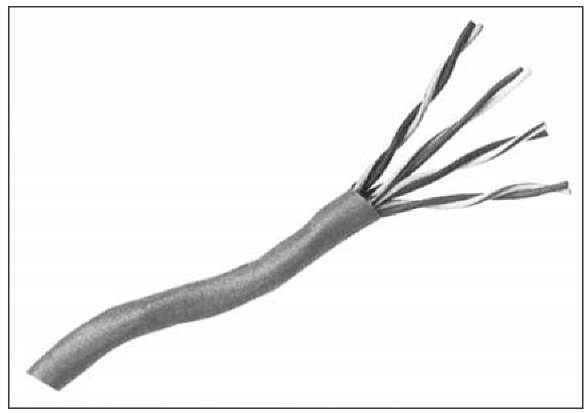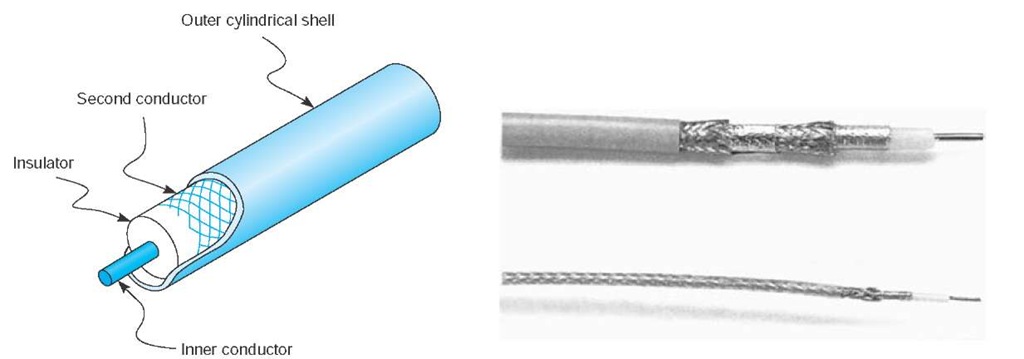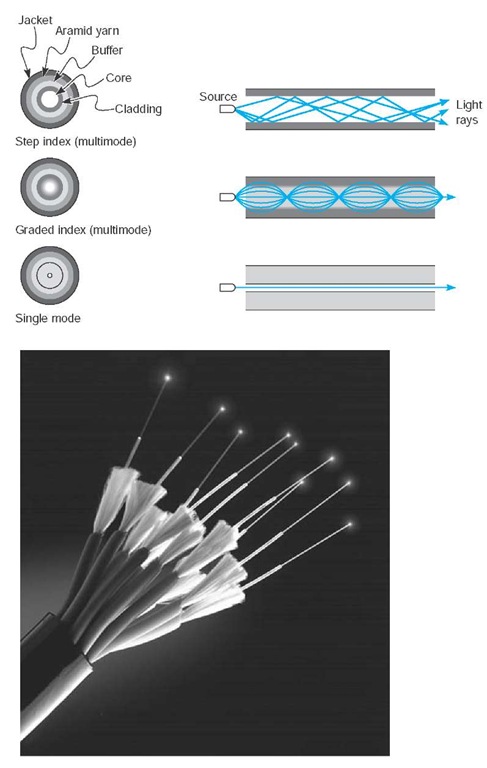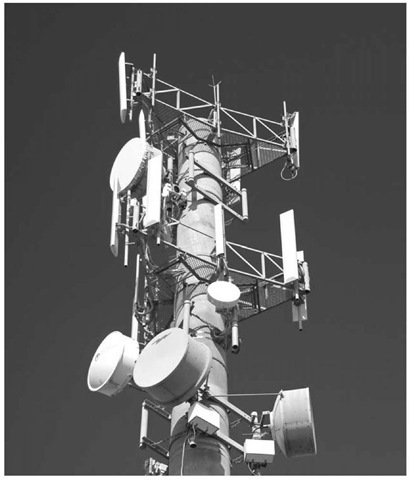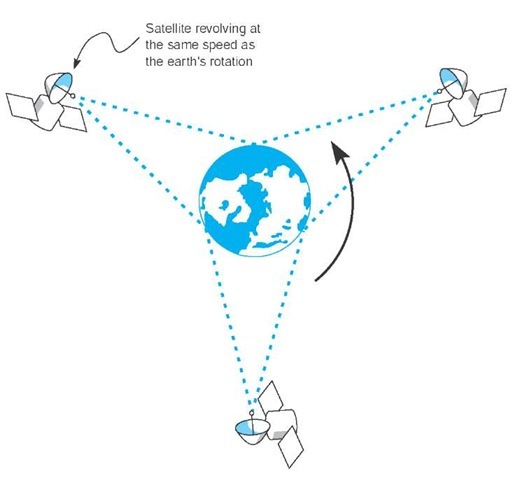The medium (or media, if there is more than one) is the physical matter or substance that carries the voice or data transmission. Many different types of transmission media are currently in use, such as copper (wire), glass or plastic (fiber-optic cable), or air (radio, infrared, microwave, or satellite). There are two basic types of media. Guided media are those in which the message flows through a physical media such as a twisted-pair wire, coaxial cable, or fiber-optic cable; the media "guides" the signal. Wireless media are those in which the message is broadcast through the air, such as infrared, microwave, or satellite.
In many cases, the circuits used in WANs are provided by the various common carriers who sell usage of them to the public. We call the circuits sold by the common carriers communication services.The following sections describe the medium and the basic characteristics of each circuit type, in the event you were establishing your own physical network, whereas next topic describes how the circuits are packaged and marketed for purchase or lease from a common carrier. If your organization has leased a circuit from a common carrier, you are probably less interested in the media used and more interested in whether the speed, cost, and reliability of the circuit meets your needs.
Guided Media
Twisted-Pair Cable One of the most commonly used types of guided media is twisted-pair cable, insulated pairs of wires that can be packed quite close together (Figure 3.9). The wires usually are twisted to minimize the electromagnetic interference between one pair and any other pair in the bundle. Your house or apartment probably has a set of two twisted-pair wires (i.e., four wires) from it to the telephone company network. One pair is used to connect your telephone; the other pair is a spare that can be used for a second telephone line. The twisted-pair cable used in LANs are usually packaged as four sets of pairs as shown in Figure 3.9, whereas bundles of several thousand wire pairs are placed under city streets and in large buildings.
Figure 3.9 Category5e twisted-pair wire
Figure 3.10 Coaxial cables. Thinnet and Thicknet Ethernet cables (right) and cross-sectional view (left)
Coaxial Cable Coaxial cable is a type of guided media that is quickly disappearing (Figure 3.10). Coaxial cable has a copper core (the inner conductor) with an outer cylindrical shell for insulation. The outer shield, just under the shell, is the second conductor. Because they have additional shielding provided by their multiple layers of material, coaxial cables are less prone to interference and errors than basic low-cost twisted-pair wires. Coaxial cables cost about three times as much as twisted-pair wires but offer few additional benefits other than better shielding. One can also buy specially shielded twisted-pair wire that provides the same level of quality as coaxial cable but at half its cost. For this reason, few companies are installing coaxial cable today, although some still continue to use existing coaxial cable that was installed years ago.
Fiber-Optic Cable Although twisted-pair is the most common type of guided media, fiber-optic cable also is becoming widely used. Instead of carrying telecommunication signals in the traditional electrical form, this technology uses high-speed streams of light pulses from lasers or LEDs (light-emitting diodes) that carry information inside hair-thin strands of glass called optical fibers. Figure 3.11 shows a fiber-optic cable and depicts the optical core, the cladding (metal coating), and how light rays travel in optical fibers.
The earliest fiber-optic systems were multimode, meaning that the light could reflect inside the cable at many different angles. Multimode cables are plagued by excessive signal weakening (attenuation) and dispersion (spreading of the signal so that different parts of the signal arrive at different times at the destination). For these reasons, early multimode fiber was usually limited to about 500 meters. Graded-index multimode fiber attempts to reduce this problem by changing the refractive properties of the glass fiber so that as the light approaches the outer edge of the fiber, it speeds up, which compensates for the slightly longer distance it must travel compared with light in the center of the fiber. Therefore, the light in the center is more likely to arrive at the same time as the light that has traveled at the edges of the fiber.
Figure 3.11 Fiber-optic cable
This increases the effective distance to just under 1,000 meters.
Single-mode fiber-optic cables transmit a single direct beam of light through a cable that ensures the light reflects in only one pattern, in part because the core diameter has been reduced from 50 microns to about 5 to 10 microns. This smaller-diameter core allows the fiber to send a more concentrated light beam, resulting in faster data transmission speeds and longer distances, often up to 100 kilometers. However, because the light source must be perfectly aligned with the cable, single-mode products usually use lasers (rather than the LEDs used in multimode systems) and therefore are more expensive.
Fiber-optic technology is a revolutionary departure from the traditional copper wires of twisted-pair cable or coaxial cable. One of the main advantages of fiber optics is that it can carry huge amounts of information at extremely fast data rates. This capacity makes it ideal for the simultaneous transmission of voice, data, and image signals. In most cases, fiber-optic cable works better under harsh environmental conditions than do its metallic counterparts. It is not as fragile or brittle, it is not as heavy or bulky, and it is more resistant to corrosion. Also, in case of fire, an optical fiber can withstand higher temperatures than can copper wire. Even when the outside jacket surrounding the optical fiber has melted, a fiber-optic system still can be used.
Wireless Media
Radio One of the most commonly used forms of wireless media is radio; when people used the term wireless, they usually mean radio transmission. When you connect your laptop into the network wirelessly, you are using radio transmission. Radio data transmission uses the same basic principles as standard radio transmission. Each device or computer on the network has a radio receiver/transmitter that uses a specific frequency range that does not interfere with commercial radio stations. The transmitters are very low power, designed to transmit a signal only a short distance, and are often built into portable computers or handheld devices such as phones and personal digital assistants.
Networking Australia
MANAGEMENT FOCUS
The Southern Cross Trans Pacific Optical Research Test bed (SX Transport), will fundamentally change the way that Australian scientists and researchers participate in global research initiatives. The network, built at a cost of almost of $50 million, provides two 10-Gbps (10 billion bits per second) capacity fiber optic circuits.
The fiber optic cables, which run at the bottom of the Pacific Ocean, connect very high speed Australian networks to very high-speed networks in the United States. One of the 10-Gbps circuits will connect through Hawaii and terminate in the U.S. at Hillsboro, Oregon, where it will interconnect with the Pacific Wave very high speed network. The second 10-Gbps circuit will terminate at San Luis Obispo in California and interconnect into other very high speed networks in the United States.
SX Transport is expected to facilitate research in astronomy, an area where Australia is a global leader. Australia is one of the nations likely to host major internationally-funded next-generation radiotelescopes, SKA (Square Kilometer Array) and LOFAR (Low Frequency Array). These telescopes will be able to peer back into the earliest days of the universe, and answer fundamental questions about howthe first stars and galaxies came into being. But the scientific and technological benefits from hosting these telescopes, plus the hundreds of millions of dollars of international investment in them, will only come to Australia if overseas researchers can access these telescopes at gigabit speeds.
Wireless technologies for LAN environments, such as IEEE 802.11n.
Infrared Infrared transmission uses low-frequency light waves (below the visible spectrum) to carry the data through the air on a direct line-of-sight path between two points. This technology is similar to the technology used in infrared TV remote controls. It is prone to interference, particularly from heavy rain, smoke, and fog that obscure the light transmission. Infrared transmitters are quite small but are seldom used for regular communication among portable or handheld computers because of their line-of-sight transmission requirements. Infrared is not very common, but it is sometimes used to transmit data from building to building.
Microwave Microwave transmission is an extremely high-frequency radio communication beam that is transmitted over a direct line-of-sight path between any two points. As its name implies, a microwave signal is an extremely short wavelength, thus the word micro wave. Microwave radio transmissions perform the same functions as cables. For example, point A communicates with point B via a through-the-air microwave transmission path, instead of a copper wire cable. Because microwave signals approach the frequency of visible light waves, they exhibit many of the same characteristics as light waves, such as reflection, focusing, or refraction. As with visible light waves, microwave signals can be focused into narrow, powerful beams that can be projected over long distances. Just as a parabolic reflector focuses a searchlight into a beam, a parabolic reflector also focuses a high-frequency microwave into a narrow beam. Towers are used to elevate the radio antennas to account for the earth’s curvature and maintain a clear line-of-sight path between the two parabolic reflectors; see Figure 3.12.
Munich Airport Provides Wireless Hotspots
MANAGEMENT FOCUS
Munich is Germany’s second-largest commercial airport, handling over 23 million passengers per year. It began offering wireless Internet access in its terminal buildings and main concourse in October 2001 and was the first wireless local area network provider to give users a choice of Internet Service Providers (ISP).
Travelers can use their home or work ISP when on the move, greatly simplifying access and billing. ISPs, which will benefit from increased loyalty and revenues, are already planning to use the pioneering multi-service provider concept elsewhere, so ultimately users may be able to travel wherever they want without having to change ISP or pay additional fees.
The hotspots are located throughout the airport. Users simply have to turn on their wireless-equipped computers and they will immediately have access to the network. If they are not existing customers of one of the offered ISPs, they can choose to access the Internet by paying €5.00 —€8.00 per hour, depending upon the ISP.
Figure 3.12 A Microwave tower. The round antennas are microwave antennas and the straight antennas are cell phone antennas.
This transmission medium is typically used for long-distance data or voice transmission. It does not require the laying of any cable, because long-distance antennas with microwave repeater stations can be placed approximately 25 to 50 miles apart. A typical long-distance antenna might be ten feet wide, although over shorter distances in the inner cities, the dish antennas can be less than two feet in diameter. The airwaves in larger cities are becoming congested because so many microwave dish antennas have been installed that they interfere with one another.
Satellite Satellite transmission is similar to microwave transmission except instead of transmission involving another nearby microwave dish antenna, it involves a satellite many miles up in space. Figure 3.13 depicts a geosynchronous satellite. Geosynchronous means that the satellite remains stationary over one point on the earth. One disadvantage of satellite transmission is the propagation delay that occurs because the signal has to travel out into space and back to earth, a distance of many miles that even at the speed of light can be noticeable.
Figure 3.13 Satellites in operation
Low earth orbit (LEO) satellites are placed in lower orbits to minimize propogation delay. Satellite transmission is sometimes also affected by raindrop attenuation when satellite transmissions are absorbed by heavy rain. It is not a major problem, but engineers need to work around it.
Satellite Communications Improve Performance
MANAGEMENT FOCUS
Boyle Transportation hauls hazardous materials nationwide for both commercial customers and the government, particularly the U.S. Department of Defense. The Department of Defense recently mandated that hazardous materials contractors use mobile communications systems with up-to-the-minute monitoring when hauling the department’s hazardous cargoes.
After looking at the alternatives, Boyle realized that it would have to build its own system. Boyle needed a relational database at its operations center that contained information about customers, pickups, deliveries, truck location, and truck operating status. Data is distributed from this database via satellite to an antenna on each truck. Now, at any time, Boyle can notify the designated truck to make a new pickup via the bidirectional satellite link and record the truck’s acknowledgment.
Each truck contains a mobile data terminal connected to the satellite network. Each driver uses a keyboard to enter information, which transmits the location of the truck. This satellite data is received by the main offices via a leased line from the satellite earth station.
This system increased productivity by an astounding 80 percent over 2 years; administration costs increased by only 20 percent.
Media Selection
Which media are best? It is hard to say, particularly when manufacturers continue to improve various media products. Several factors are important in selecting media (Figure 3.14).
• The type of network is one major consideration. Some media are used only for WANs (microwaves and satellite), whereas others typically are not (twisted-pair, coaxial cable, radio, and infrared), although we should note that some old WAN networks still use twisted-pair cable. Fiber-optic cable is unique in that it can be used for virtually any type of network.
• Cost is always a factor in any business decision. Costs are always changing as new technologies are developed and as competition among vendors drives prices down. Among the guided media, twisted-pair wire is generally the cheapest, coaxial cable is somewhat more expensive, and fiber-optic cable is the most expensive. The cost of the wireless media is generally driven more by distance than any other factor. For very short distances (several hundred meters), radio and infrared are the cheapest; for moderate distances (several hundred miles), microwave is cheapest; and for long distances, satellite is cheapest.
• Transmission distance is a related factor. Twisted pair wire, coaxial cable, infrared, and radio can transmit data only a short distance before the signal must be regenerated. Twisted-pair wire and radio typically can transmit up to 100 to 300 meters, and coaxial cable and infrared typically between 200 and 500 meters. Fiber optics can transmit up to 75 miles, with new types of fiber-optic cable expected to reach more than 600 miles.
|
|
Guided Media |
|
||||
|
Media |
Network Type |
Cost |
Transmission Distance |
Security |
Error Rates |
Speed |
|
Twisted Pair |
LAN |
Low |
Short |
Good |
Low |
Low-high |
|
Coaxial Cable |
LAN |
Moderate |
Short |
Good |
Low |
Low-high |
|
Fiber Optics |
Any |
High |
Moderate-long |
Very good |
Very low |
High-very high |
|
Radiated Media |
||||||
|
Media |
Network Type |
Cost |
Transmission Distance |
Security |
Error Rates |
Speed |
|
Radio |
LAN |
Low |
Short |
Poor |
Moderate |
Moderate |
|
Infrared |
LAN, BN |
Low |
Short |
Poor |
Moderate |
Low |
|
Microwave |
WAN |
Moderate |
Long |
Poor |
Low-moderate |
Moderate |
|
Satellite |
WAN |
Moderate |
Long |
Poor |
Low-moderate |
Moderate |
Figure 3.14 Media summary. BN = backbone network; LAN = local area network; WAN = wide area network
• Security is primarily determined by whether the media is guided or wireless. Wireless media (radio, infrared, microwave, and satellite) are the least secure because their signals are easily intercepted. Guided media (twisted pair, coaxial, and fiber optics) are more secure, with fiber optics being the most secure.
• Error rates are also important. Wireless media are most susceptible to interference and thus have the highest error rates. Among the guided media, fiber optics provides the lowest error rates, coaxial cable the next best, and twisted-pair cable the worst, although twisted-pair cable is generally better than the wireless media.
• Transmission speeds vary greatly among the different media. It is difficult to quote specific speeds for different media because transmission speeds are constantly improving and because they vary within the same type of media, depending on the specific type of cable and the vendor. In general, both twisted-pair cable and coaxial cable can provide data rates of between 1 and 100 Mbps (1 million bits per second), whereas fiber-optic cable ranges between 100Mbps and 10 Gbps (10 billion bits per second). Radio and infrared generally provide 1 to 50Mbps, as do microwave and satellite.
